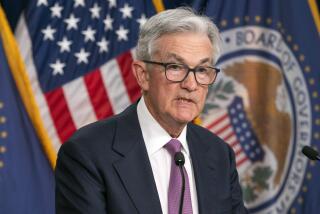Downward revision of GDP growth a strong signal of stalled recovery
Reporting from Washington — The Commerce Department on Friday downgraded the nation’s economic growth in the second quarter, providing the most important evidence yet that the recovery has stalled.
The anemic annualized growth rate of 1.6% was down from last month’s estimate of 2.4%. The drop was slightly less than many economists had predicted, but the report still put an exclamation point on a week of bad economic news that has raised fears the nation could plunge into another recession.
Responding to those concerns, Federal Reserve Chairman Ben S. Bernanke said Friday that the central bank was prepared to step in if necessary to help provide additional stimulus to the economy and avoid the type of debilitating deflation that struck Japan in the 1990s.
He outlined three possible options, including expanding its purchases of long-term securities to pump more money into the economy and signaling that the central bank will keep its short-term interest rate near zero for longer than the vague “extended period” it has promised.
“The Federal Reserve is already supporting the economic recovery by maintaining an extraordinarily accommodative monetary policy, using multiple tools,” Bernanke told a major economic gathering in Jackson Hole, Wyo., according to a copy of his remarks released by the Fed.
“Should further action prove necessary, policy options are available to provide additional stimulus. Any deployment of these options requires a careful comparison of benefit and cost.”
In his highly anticipated comments, Bernanke added that despite the “recent slowing” in economic growth, “it is reasonable to expect some pickup in growth in 2011 and in subsequent years.” But the high unemployment -- at 9.5% in July -- is expected to “decline only slowly,” he said.
“The prospect of high unemployment for a long period of time remains a central concern of policy,” Bernanke said.
The Commerce Department’s Bureau of Economic Analysis said Friday’s downward revision was based on more complete data and “primarily reflected a sharp acceleration in imports and a sharp deceleration in private inventory investment” by businesses. Those drops were partially offset by an increase in residential and nonresidential investment, as well as increases in federal, state and local government spending.
Federal stimulus and other spending was a big boost from April through June, with expenditures and investment up 9.1% in the second quarter, compared with an increase of 1.8% in the first quarter of the year, the report said. But the nonpartisan Congressional Budget Office reported this week that the effect of last year’s $814-billion stimulus legislation would gradually diminish in the second half of the year.
The widening trade deficit was a major drag on the recovery in the second quarter. Real exports of goods and services increased 9.1% in the second quarter, compared with an 11.4% increase in the first quarter. Imports soared 32.4% in the second quarter after rising 11.2% in the first.
The government routinely revises its reports on domestic economic output, also known as Gross Domestic Product.
Friday’s revision comes after an advance estimate of second-quarter GDP that was released July 30. The average revision is about 0.5%.
Economists had projected second-quarter GDP could fall to 1.3% or lower. Still, Friday’s report was discouraging because growth below 2% reflects a very weak recovery. The economy had grown at a 3.7% rate in the first quarter and 5% in the final three months of last year.
The downward revision follows horrible housing reports that hit Tuesday.
Thursday brought some more potentially discouraging news on home foreclosures and unemployment. Investors demonstrated their concern, dropping the blue-chip Dow Jones industrial average 74 points to close below 10,000 Thursday for the first time since early July.
The Dow was up slight in early trading Friday. Consumer sentiment in August remained largely unchanged, according to survey results released Friday by Thompson Reuters and the University of Michigan. Only one in four households expected their finances to improve in the year ahead, the survey found.
The downward revision of second-quarter economic activity came as other forecasts projected slow growth.
Last month, Federal Reserve Chairman Ben S. Bernanke declared that the economic outlook was “unusually uncertain.” Concerned about the pace of recovery, the Fed this month decided to start buying U.S. Treasury bonds again to keep down longer-term interest rates.
The central bank this year had begun pulling back its extraordinary support for the financial system, but jumped back into the bond market this month because Fed policymakers said the recovery “appeared more modest in the near term than had been anticipated.”
Bernanke is set to address the economic situation later Friday morning in a speech at the Fed’s annual Economic Policy Symposium in Jackson Hole, Wyo., a high-level gathering of central bankers, finance ministers, academics and industry executives from around the world. It will be his first public comments since the Fed announced its plan to resume purchases of Treasury bonds.
But with the Fed’s benchmark short-term interest rate near zero, its policy options are limited. The Fed’s most recent economic forecast, in late June, called for economic growth of 3% to 3.5% this year, slower than the 4% growth in the last half of 2009.
Bernanke said Friday that the central bank could decide to expand its purchases of long-term securities, signaling low interest rates will last much longer, or lower the interest rate the Fed pays to commercial banks for their reserves, which would encourage them to lend the money.
He said there was not a significant risk of the economy “falling into deflation” -- a harmful cycle of lower prices that damages growth. But he said the Fed was prepared to act in such a case to “strongly resist deviations from price stability in the downward direction.”
More to Read
Inside the business of entertainment
The Wide Shot brings you news, analysis and insights on everything from streaming wars to production — and what it all means for the future.
You may occasionally receive promotional content from the Los Angeles Times.











